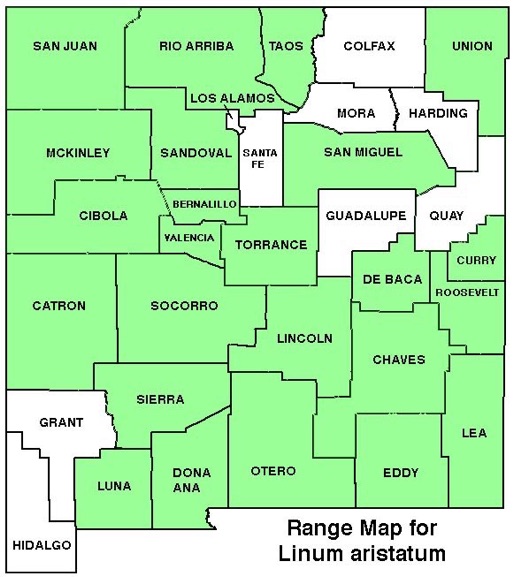WILDFLOWERS OF NEW MEXICO

Densely branching from the base, bushy stems reach 18-inches tall with numerous delicate yellow flowers that last only one day. Note the hairless stems, flowers solid yellow or with only faint red lines leading into the throat, slender tapering sepals under the petals, and sharp-pointed leaves.
FLOWER: May–August. 5 yellow-orange petals 3/8–1/2-inch long (8–12 mm); sepals slender, tapering to a point 1/4–3/8-inch long (6–9 mm), nearly as long as the basal portion, making the buds shapely pointed. This Linum has styles united at the base with stigmas spreading at the tip.
LEAVES: Alternate. Narrow, linear, 1/8–3/4-inch (5–20 mm) long, to 3/16-inch (4 mm) wide, sharply pointed, usually with glands on minute stems (stipular) (use lens).
HABITAT: Deep sand, gravelly soils, dunes, washes, wind-blown areas; prairies, desert grasslands and scrub, sandy scrublands, pinyon-juniper-oak, pine-Douglas fir forests.
ELEVATION: 3,400-9,200 feet.
RANGE: AZ, NM, UT, TX.
SIMILAR SPECIES: 13 species of yellow flax in NM, many with only minute differences; all but one have hairless stems. Yellow Desert Flax, L. puberulum, statewide, has flowers with maroon throat, and stems covered with short hairs (use lens). Southern Flax, L. australe, statewide, has flowers without a maroon base , more prominent lower leaves, and branches from about half-way up the stem.
NM COUNTIES: Almost statewide in low- to mid-elevation, deep-sandy habitats: Bernalillo, Catron, Chaves, Cibola, Curry, De Baca, Dona Ana, Eddy, Lea, Lincoln, Luna, McKinley, Rio Arriba, Roosevelt, Otero, San Juan, San Miguel, Sandoval, Sierra, Socorro, Taos, Torrance, Union, Valencia.

BRISTLE FLAX
LINUM ARISTATUM
Flax Family, Linaceae
Annual herb

THE CONTENTS OF THIS WEBSITE ARE COPYRIGHTED AND CANNOT BE USED
WITHOUT PERMISSION OF GEORGE OXFORD MILLER






-
1.Sharp-pointed buds (upper arrow).
-
2.Tapering pointed sepals (middle arrow).
-
3.Hairless stems (lower arrow).


Sharp-pointed leaves (arrow).


Style united at base with spreading stigmas at tip.
The stem starts branching near the base.
EMAIL ME
